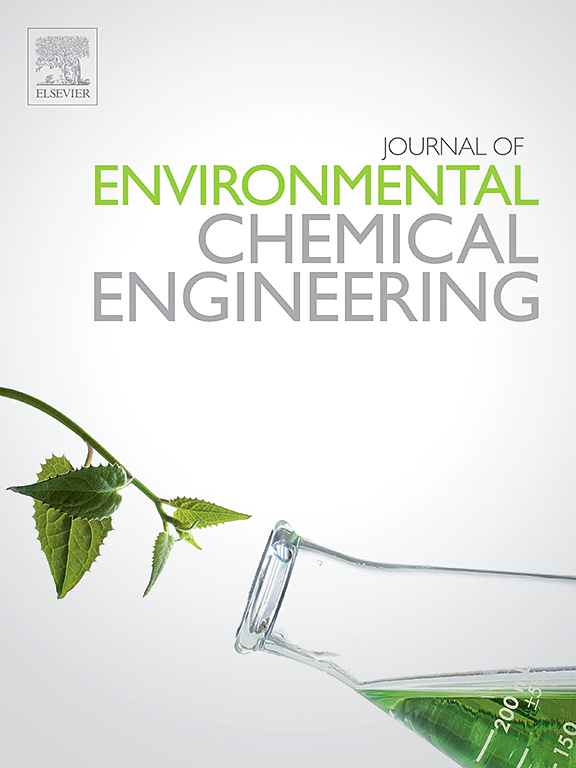State-of-the-art approaches in sago wastewater treatment and resource recovery: Towards a circular and sustainable industry
IF 7.2
2区 工程技术
Q1 ENGINEERING, CHEMICAL
引用次数: 0
Abstract
The sago industry plays a crucial role in global food security, but its production generates wastewater rich in nutrients and organic matter, which pose serious environmental challenges. This study critically reviews recent advances in sago wastewater treatment technology and proposes a scalable, nature-based, integrated treatment framework that is in line with Malaysia’s Sustainable Development Goals (SDG6, SDG12, SDG14 and SDG15) and the principles of the circular economy. The proposed system combines anaerobic digestion, coagulation–flocculation, bioadsorption and phytoremediation. Scientific reports show that anaerobic digestion can reduce chemical oxygen demand (COD) by 70 %–95 %, but residual total suspended solids (TSS ≥200 mg/L) and nutrients (nitrogen ≥100 mg/L, phosphorus ≥30 mg/L) still require further treatment. The coagulation–flocculation method using natural biocoagulants successfully removes up to 81.5 % of TSS, and bioadsorption using activated carbon achieves impressive removal efficiencies of 81.16 % for total dissolved solids, 87.58 % for TSS, 91.32 % for COD and 48.66 % for biochemical oxygen demand (BOD) in sago industry wastewater. Phytoremediation using Scirpus grossus and Chlorella pyrenoidosa improves effluent quality by reducing TSS by up to 98 %, COD by up to 90.2 % and BOD by up to 93 %. These findings confirm the feasibility of a cost-effective, phased, sustainable, nature-based effluent treatment model. Analysis of strengths, weaknesses, opportunities and threats is also conducted to assess the potential implementation and feasibility of this system in the context of a circular economy. This study provides a strategic plan for policymakers, industry players and researchers to accelerate the transition towards sustainable sago industry development.
西米废水处理和资源回收的最新方法:迈向循环和可持续的工业
西米产业在全球粮食安全中发挥着至关重要的作用,但其生产产生的废水富含营养物质和有机物,对环境构成严重挑战。本研究回顾了西米废水处理技术的最新进展,并提出了一个可扩展的、基于自然的综合处理框架,该框架符合马来西亚的可持续发展目标(SDG6、SDG12、SDG14和SDG15)和循环经济原则。该系统结合了厌氧消化、混凝-絮凝、生物吸附和植物修复。科学报告表明,厌氧消化可使化学需氧量(COD)降低70 % -95 %,但残余总悬浮物(TSS≥200 mg/L)和营养物质(氮≥100 mg/L,磷≥30 mg/L)仍需进一步处理。使用天然生物混凝剂的混凝-絮凝法对西米工业废水中TSS的去除率高达81.5 %,活性炭生物吸附法对总溶解固形物的去除率为81.16 %,对TSS的去除率为87.58 %,对COD的去除率为91.32 %,对生化需氧量(BOD)的去除率为48.66 %。利用粗螺旋藻和核核小球藻进行植物修复,可将TSS降低高达98 %,COD降低高达90.2 %,BOD降低高达93 %,从而改善出水质量。这些发现证实了一种具有成本效益的、分阶段的、可持续的、基于自然的污水处理模式的可行性。还对优势、劣势、机会和威胁进行了分析,以评估该系统在循环经济背景下的潜在实施和可行性。本研究为政策制定者、行业参与者和研究人员加速西米产业向可持续发展转型提供了战略规划。
本文章由计算机程序翻译,如有差异,请以英文原文为准。
求助全文
约1分钟内获得全文
求助全文
来源期刊

Journal of Environmental Chemical Engineering
Environmental Science-Pollution
CiteScore
11.40
自引率
6.50%
发文量
2017
审稿时长
27 days
期刊介绍:
The Journal of Environmental Chemical Engineering (JECE) serves as a platform for the dissemination of original and innovative research focusing on the advancement of environmentally-friendly, sustainable technologies. JECE emphasizes the transition towards a carbon-neutral circular economy and a self-sufficient bio-based economy. Topics covered include soil, water, wastewater, and air decontamination; pollution monitoring, prevention, and control; advanced analytics, sensors, impact and risk assessment methodologies in environmental chemical engineering; resource recovery (water, nutrients, materials, energy); industrial ecology; valorization of waste streams; waste management (including e-waste); climate-water-energy-food nexus; novel materials for environmental, chemical, and energy applications; sustainability and environmental safety; water digitalization, water data science, and machine learning; process integration and intensification; recent developments in green chemistry for synthesis, catalysis, and energy; and original research on contaminants of emerging concern, persistent chemicals, and priority substances, including microplastics, nanoplastics, nanomaterials, micropollutants, antimicrobial resistance genes, and emerging pathogens (viruses, bacteria, parasites) of environmental significance.
 求助内容:
求助内容: 应助结果提醒方式:
应助结果提醒方式:


